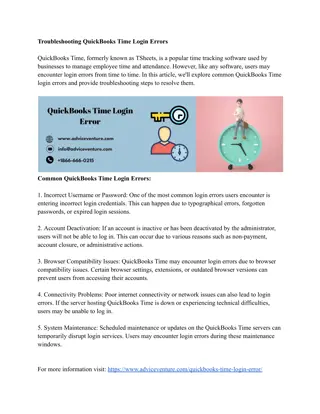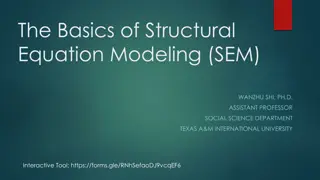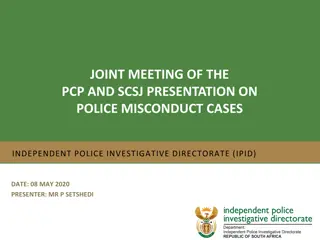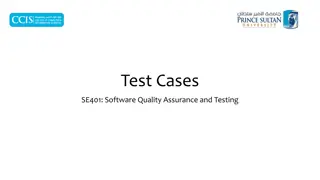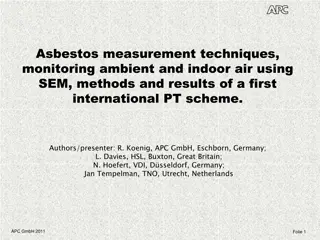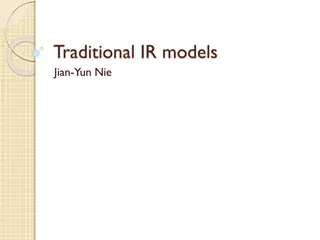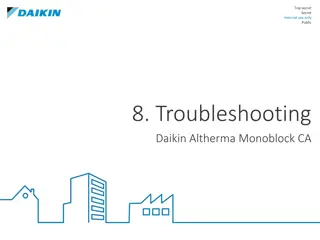Troubleshooting Heywood Cases in SEM Models
In structural equation modeling (SEM), encountering improper solutions like negative variance parameters and non-positive definite covariance matrices is common. These issues can lead to untrustworthy results and affect the standard errors of estimates. This segment provides insights on recognizing and fixing such problems, along with examples and causes of improper solutions in SEM. Understanding the importance of correctly diagnosing and addressing these issues is crucial for generating reliable SEM models.
Download Presentation

Please find below an Image/Link to download the presentation.
The content on the website is provided AS IS for your information and personal use only. It may not be sold, licensed, or shared on other websites without obtaining consent from the author.If you encounter any issues during the download, it is possible that the publisher has removed the file from their server.
You are allowed to download the files provided on this website for personal or commercial use, subject to the condition that they are used lawfully. All files are the property of their respective owners.
The content on the website is provided AS IS for your information and personal use only. It may not be sold, licensed, or shared on other websites without obtaining consent from the author.
E N D
Presentation Transcript
Troubleshooting problems with SEM models that have Heywood cases such as negative variance parameters and non-positive definite covariance matrices Jeremy Yorgason Brigham Young University
Introduction In SEM, it is fairly common to encounter Improper Solutions Non-positive definite covariance matrices Models with negative variance terms Negative PSI matrix Correlation or other standardized values > 1 Model is not identified, you need x number of constraints for it to be identified Why is this important? Results from models that have this problem cannot be trusted, and shouldn t be reported in journal articles. Standard errors of estimates may be affected (Chen et al., 2001) Error messages are Diagnostic tools It s a good idea to confirm the diagnosis that the computer system is giving you The point is to understand what may be going on with your model/data This often requires that you look at all of the output for your model
Goals for this Segment of the Workshop 1.How do I recognize the problem? 2.How do I fix the problem? 3.Examples
Causes of Improper Solutions in SEM 1. Specification error in the model A.Missing a 1 on one of the factor loadings of a latent variable, or on an error term B.Correlations of variables or errors from IV to DV of a model C.Excessive error correlations on indicators of a single latent variable D.Very low factor loadings on a latent variable E.Omitted paths that should be in a model 2. Model under-identified (negative degrees of freedom) A. V(V+1)/2 minus parms (if estimating means/intercepts use V(V+3)/2) 3. Non-convergence 4. Outliers in the data 5. Too small of sample for the model being estimated Kline, 2011; Kolenikov & Bollen, 2012; Chen et al., 2001; Newsome, 2012
Causes of Improper Solutions in SEM 6. Missing data 7. Sampling fluctuations 8. Two indicator latent variables A.This includes 2nd order latent variables 9. Non-normally distributed outcome or indicator variables in your model A.Categorical B.Count, zero-inflated, etc. 10. Empirical under-identification A. Positive degrees of freedom, but there is insufficient covariance information in a portion of the model for the computer to generate valid estimates (Newsome, 2012) B.May be caused by some of the above issues Kline, 2011; Kolenikov & Bollen, 2012; Chen et al., 2001; Newsome, 2012
Signs that there is a problem Amos: XX: Default Model The following variances are negative. This solution is not admissible The model is probably unidentified. In order to achieve identifiability, it will probably be necessary to impose 1 additional constraint. In place of estimates in the Amos output you see unidentified
Signs that there is a problem Mplus: THE MODEL ESTIMATION TERMINATED NORMALLY THE STANDARD ERRORS OF THE MODEL PARAMETER ESTIMATES MAY NOT BE TRUSTWORTHY FOR SOME PARAMETERS DUE TO A NON-POSITIVE DEFINITE FIRST- ORDER DERIVATIVE PRODUCT MATRIX. THIS MAY BE DUE TO THE STARTING VALUES BUT MAY ALSO BE AN INDICATION OF MODEL NONIDENTIFICATION. THE CONDITION NUMBER IS -0.762D-17. PROBLEM INVOLVING PARAMETER 59. MODIFICATION INDICES COULD NOT BE COMPUTED. THE MODEL MAY NOT BE IDENTIFIED.
More signs that there is a problem Mplus or other programs: 1. Negative variance estimate (remember Variance = stddev2) A. Find it in your output 2. Correlations above 1 (remember, can t be larger than 1) A. Find it in your output 3. Error variance that is really BIG (999 usually indicates a problem in Mplus, although this is ok if something is constrained to be a certain number)
How can I fix these problems? Look at a diagram of your model and see if you have miss-specified your model. A. Check your syntax (e.g., look for missing semi-colons in Mplus) B. Missing 1 for a factor loading on latent variables C. Missing 1 on regression path of error term D. Sometimes Amos creates GHOST variables. You can t see them, but they are there! Sometimes off the screen, sometimes really, really, really,small E. Sometimes Amos will double correlate variables F. Any correlations across IV/DV lines? 1. Careful, this is something your modification indices will suggest to improve model fit. However, don t ever add parameters that go against theory G. Make sure you have appropriate regression paths in the model (not too few, in this case) H. Make sure your measurement model is appropriate A. Factor loadings > .40 B. Error correlations start with none, correlation between items is captured in the latent variables. Typically you ll use mod indices here 1.
How can I fix these problems? 2. Researchers need to be attentive to model problems when there are latent variables with only 2 indicators (can be unstable) A. Newsom (2012) suggests constraining the two factor loadings to be equal 3. Caution is also warranted when estimating higher order latent variables with only two factors, and certain complex models (e.g., common fate models) that require specific constraints in order for the model to be identified
How can I fix these problems? 4. Either use a large sample , OR check the sample size and compare with the number of parameters being estimated. N/q rule (n = sample, q = parameters in the model; Kline, 2011) Count variances, covariances, and means OR Most programs tell you how many parms are in your model. Amos: Number of distinct sample moments: 77 Number of distinct parameters to be 44 estimated: Degrees of freedom (77 - 44): 33 Quick Check: 10 people in the sample for every observed (rectangle) variable in the model
How can I fix these problems? 5. If your model looks to be specified correctly, but you still have a problem with the model, it s time to start looking at your data A. Run a frequency on all variables in the model, to see if there is some data entry error or outliers that could be inflating the variance of one or more variables 1. Side note: sometimes SEM models have trouble with variables that have very different (larger or smaller) variance values than the rest of the variables in your model (e.g., income in dollars) 2. If this is the case, you will want to rescale or transform these variables to ensure similar variances 3. Also, in the transfer of data from one program to another, sometimes columns of data are shifted or otherwise corrupted
How can I fix these problems? 6. Do you have any categorical or non-normally distributed dependent variables that are specified as continuous? A. Amos doesn t handle dichotomous, count, or zero inflated outcomes B. Mplus does handle them well, but you have to specify in the syntax that you are working with such distributions C. You may have specified non-normal variable distributions, but you have small cell sizes (e.g., ordered categorical variable with only 1 or 2 cases on one end of the distribution)
How can I fix these problems? 7. If your model does not converge it means that the program went through X number of iterations, but could not find a suitable solution. You can increase iterations from the default number to try to estimate your model. If this doesn t work, you probably need to change your model or you have a data problem.
Atypical Solutions: Start Values and Iterations 8. A start value is a number assigned to each estimated parameter when iterations begin for a model. Amos and Mplus automatically create start values for each parameter to be estimated, yet it is possible to assign start values if the program assigned ones don t work. Researchers can provide start values for a model, which are essentially any known parameter estimates (e.g., regression weight or coefficient). You can get these by running simple linear regression with the variables in your model, and then plug in the coefficient from the simpler model. A. How in the world would I know if I have bad start values??? B. How would I know what variable to look at that might be non- normally distributed? Or be categorical and have small cell sizes?
Greek Alphabet and Mplus Output Nu ( / )= intercepts or means of observed variables Lambda ( / )= Factor Loadings Theta ( / )= error variances and covariances Alpha ( / )= means and intercepts of latent variables Beta ( / ) and Gamma ( / ) = regression coefficients Psi ( / )= residual variances and covariances of continuous latent variables Tau ( / ) = thresholds of categorical observed variables Delta ( / ) = scaling information for observed dependent variables Etc. see Mplus manual Ask for Tech1 in the output and then when Mplus says there is a problem with, for example, parameter #16, go and find that parameter and see which matrix it is in and then identify the variable and go look at the model/data to see where the problem is. If no variable is identified, need to go back to Model Specification. CAUTION: Specific Parameter warnings are usually a DECOY! They generally are simply letting you know the model is not correctly specified, and no matter what you do to the identified variable it will not make your model work.
Examples: Message of Death! From a class assignment with a model involving 56 cases. Mplus error: THE MODEL ESTIMATION TERMINATED NORMALLY THE STANDARD ERRORS OF THE MODEL PARAMETER ESTIMATES MAY NOT BE TRUSTWORTHY FOR SOME PARAMETERS DUE TO A NON-POSITIVE DEFINITE FIRST-ORDER DERIVATIVE PRODUCT MATRIX. THIS MAY BE DUE TO THE STARTING VALUES BUT MAY ALSO BE AN INDICATION OF MODEL NONIDENTIFICATION. THE CONDITION NUMBER IS 0.383D-13. PROBLEM INVOLVING PARAMETER 31. THIS IS MOST LIKELY DUE TO HAVING MORE PARAMETERS THAN THE SAMPLE SIZE IN ONE OF THE GROUPS. WARNING: THE RESIDUAL COVARIANCE MATRIX (THETA) IN GROUP GRAD IS NOT POSITIVE DEFINITE. THIS COULD INDICATE A NEGATIVE VARIANCE/RESIDUAL VARIANCE FOR AN OBSERVED VARIABLE, A CORRELATION GREATER OR EQUAL TO ONE BETWEEN TWO OBSERVED VARIABLES, OR A LINEAR DEPENDENCY AMONG MORE THAN TWO OBSERVED VARIABLES. CHECK THE RESULTS SECTION FOR MORE INFORMATION. PROBLEM INVOLVING VARIABLE DE4.
Atypical Solutions: Sampling Fluctuations Model is specified correctly Don t have outliers in your data, and you have a large enough sample to estimate the model at hand Model is not identified, although you have positive degrees of freedom 9. Possible tests to confirm you have sampling fluctuations and not some other problem: Confidence interval from standard errors includes a zero Calculate a z by taking the ratio Estimate: Standard Error, and then compare to a z distribution Wald test, take ratio (Estimate:Standard Error)2 then compare to a chi-square distribution with 1 df Likelihood ratio test statistic Lagrangian multiplier (mod indices when var constrained to 0) Boostrap resampling method (esp. with non-normal data) Scaled chi-square difference test Signed root tests Empirical sandwich estimators
Atypical Solutions: Sampling Fluctuations Model is specified correctly Don t have outliers in your data, and you have a large enough sample to estimate the model at hand Model is not identified, although you have positive degrees of freedom Fix the negative variance to 0 or to a small positive number This can affect model parameters
Handout Chen et al (2001) suggested decision tree 1. Is your model identified? 2. If so, do you have any negative error variances? 3. If so, do you have any outliers that are a problem? 4. If not, is the model empirically underidentified? 5. If not, do you have sampling fluctuations? 6. If so, constrain the negative variance to be 0, a small positive number, or to be the population variance Newsome (2012) prevention tips Careful specification Use larger samples Model factors with 3 or more indicators Use reliable measures (high loadings) Well conditioned data
Working Example See Amos Program Depending on time, manipulate an example to show what errors commonly occur, what the program tells you, and how to fix the problems
Conclusion Either . Work with perfect data and perfect models OR Learn to interpret SEM error messages, and how to fix common problems
References Chen, F., Bollen, K. A., Paxton, P., Curran, P., & Kirby, J. (2001).Improper solutions in structural equation models: Causes, consequences, and strategies. Sociological Methods and Research, 29, 468-508. Kline, R. B. (2011). Principles and practices of structural equation modeling (3rd Ed). New York, NY: Guilford Press. Kolenikov, S. & Bollen, K. A. (2012). Testing negative error variances: Is a Heywood case a symptom of misspecification? Sociological Methods and Research, 41, 124-167.







